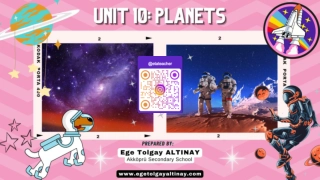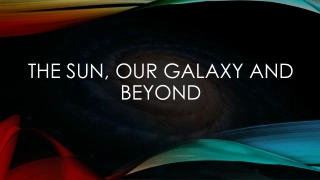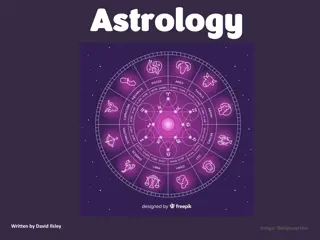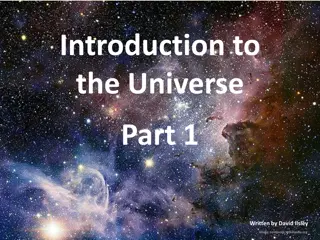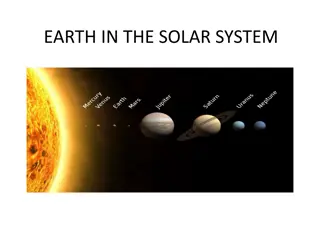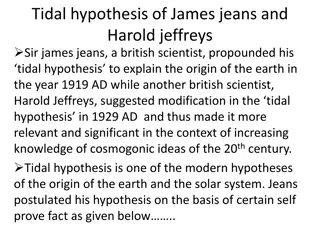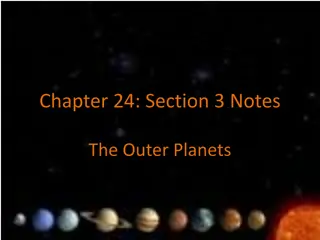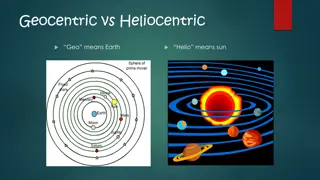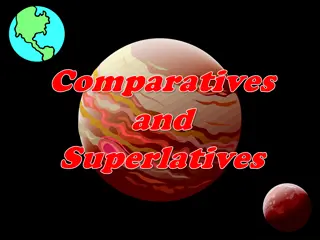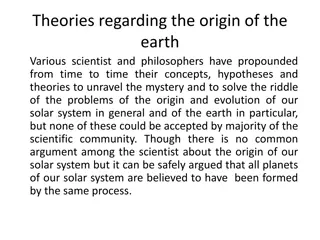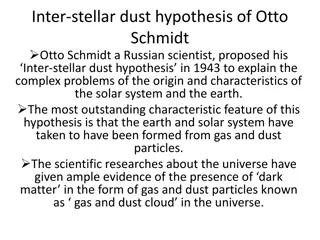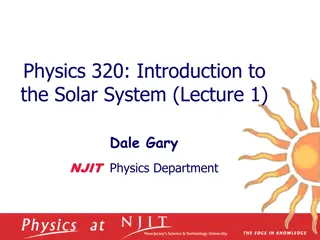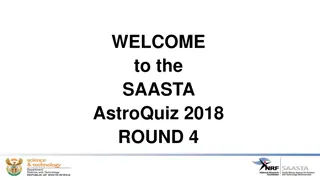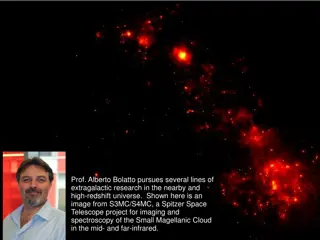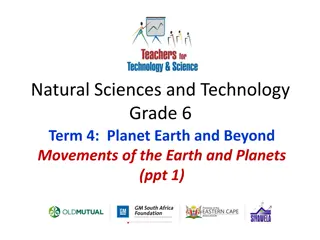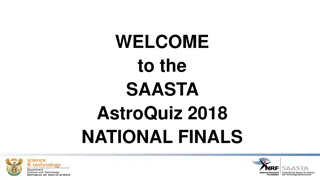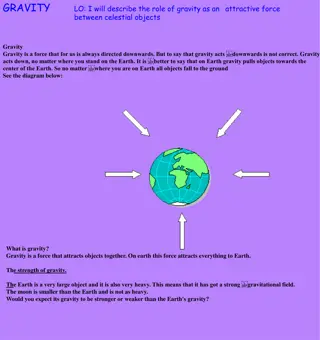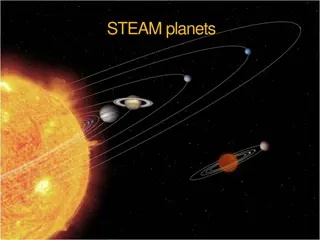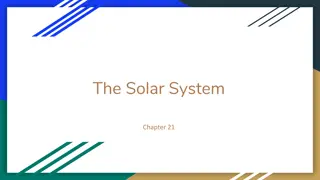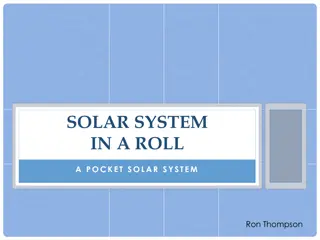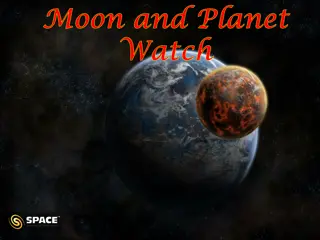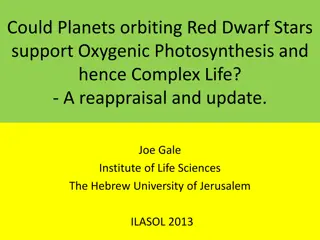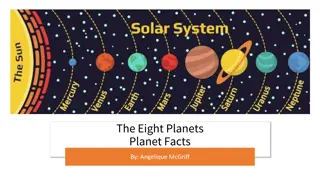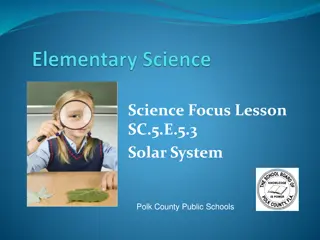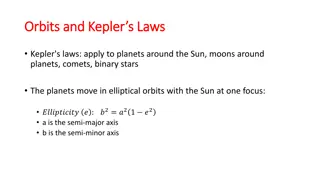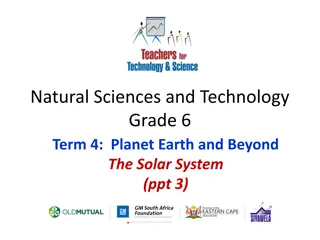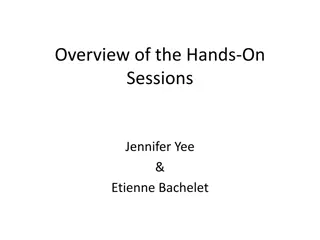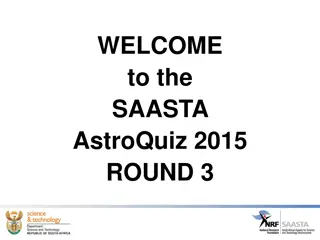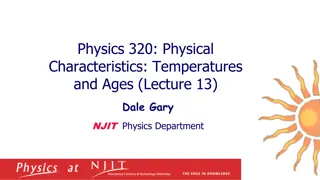A Complete Guide to Janam Kundali
Are you intrigued by the janam kundali by date of birth in hindi mystical insights offered by Janam Kundali? Delve into the depths of your destiny with our comprehensive guide. Here's all you need to know about janam kundali in hindi, its analysis, and how to obtain it for free.\n\nWhat is Janam Kun
2 views • 2 slides
The 8 Planets in Our Solar System and More
Discover the 8 planets in our solar system - Jupiter, Earth, Uranus, Mercury, Sun, Mars, Venus, Neptune - plus dwarf planet Pluto. Explore space-related words and images in this educational content.
11 views • 41 slides
Exploring Our Sun, Galaxy, and Beyond
Delve into the fascinating world of the sun, our galaxy, and the vast expanse of space. Learn about the sun being a star at the center of our solar system, the planets orbiting it, the diversity of stars in the universe, and the Milky Way galaxy that we call home. Discover Proxima Centauri, our clos
1 views • 22 slides
Understanding Terrestrial Planets and Core Dynamics
Exploring the core-mantle interaction from the early Hadean period to present times reveals intriguing questions about the outer core's electrical conductivity, geodynamo sustainability, and inner core characteristics. Studies indicate challenges in maintaining the geodynamo, potential heat sources
9 views • 48 slides
The History of the Earth
The Earth, 4.5 billion years old, emerged from a nebula in the Milky Way Galaxy. Gravity led to the condensation of a rotating cloud into the Sun and planets. Over time, lumps collided, forming gas giants, rocky planets, and asteroids. The outer planets attracted hydrogen and helium, while the inner
2 views • 45 slides
English Grade 6 Unit 2 Review - Will It Really Happen
Explore key language and grammar concepts in Unit 2 of English Grade 6 through engaging activities like matching pictures, completing sentences, circling correct answers, and writing sentences about the future. Practice using "will" and "won't" to discuss futuristic scenarios such as space travel an
6 views • 7 slides
The Evolution of Astrology: From Agricultural Significance to Cultural Importance
Humans discovered the agricultural implications of studying the stars post Ice Age, leading to improved harvests and settled communities. Astrologers interpreted celestial movements for predicting events, with planets playing a crucial role. Their perceived wisdom elevated their status in society, s
4 views • 25 slides
An Exploration of the Vast Universe - Part 1
Delve into the intriguing magnitudes of celestial bodies and distances within our solar system, from the massive scale of the Sun to the minute size of Neptune in relation to the Earth. Discover the diversity of stars, planets, and dwarf bodies that populate our cosmic neighborhood, showcasing the i
3 views • 48 slides
Understanding Celestial Bodies and Constellations in the Universe
Explore the fascinating world of celestial bodies in the universe, including stars, galaxies, planets, and constellations. Learn about the formation of stars, the structure of galaxies like the Milky Way, and how constellations have been observed and named throughout history. Discover the significan
0 views • 28 slides
The Tidal Hypothesis of James Jeans and Harold Jeffreys: Origin of the Earth
The Tidal Hypothesis proposed by British scientists James Jeans and Harold Jeffreys in the early 20th century suggested that the Earth and solar system were formed from the interaction of the Sun and an intruding star. Jeans postulated that massive gravitational forces from the intruding star caused
2 views • 5 slides
Exploring the Outer Planets: Jupiter and Saturn
Discover fascinating details about the outer planets Jupiter and Saturn, from Jupiter's gaseous composition and iconic Great Red Spot to Saturn's impressive rings and unique characteristics like being the "Ringed Planet." Explore the moons of Jupiter, including the Galilean Moons, and learn about Sa
0 views • 18 slides
The Revolution of the Solar System: Geocentric vs Heliocentric Theories
The geocentric theory placed Earth at the center of the universe, with all planets revolving around it, while the heliocentric theory proposed the Sun as the central body. Influential figures like Aristotle, Ptolemy, and Copernicus greatly impacted the understanding of our solar system, leading to p
1 views • 12 slides
Fun Facts About the Solar System and Planets
Explore interesting comparisons between celestial bodies in our Solar System. Images and descriptions highlight the size, temperature, distance, and other unique characteristics of planets like Jupiter, Mars, Earth, Saturn, Neptune, Mercury, Venus, and more. Learn fascinating facts about these cosmi
0 views • 12 slides
Theories on the Origin of Earth and Solar System
Scientists and philosophers have proposed various theories regarding the origin of Earth and our solar system, with concepts ranging from evolutionary to catastrophic. The Dust gas cloud theory, Planetesimal hypothesis, Binary star hypothesis, and more have been suggested to explain how planets were
4 views • 7 slides
The Interstellar Dust Hypothesis of Otto Schmidt Explained
Russian scientist Otto Schmidt proposed the Interstellar Dust Hypothesis in 1943 to explain the origin of the solar system and Earth. According to this hypothesis, gas and dust particles from the universe formed our solar system. The dark matter in the form of gas and dust clouds played a crucial ro
3 views • 5 slides
Exploring Solar System Planets and Market Trends
Discover interesting facts about planets in our solar system alongside market trends analysis. Learn about the sizes, positions, and unique features of Mercury, Saturn, Neptune, Jupiter, Venus, and more. Follow along with engaging visual charts and comparisons. Dive into competition analysis, break-
0 views • 7 slides
Exploring the Solar System and Beyond
Delve into the fascinating world of the Solar System and beyond with discussions on its composition, structure, and the language of astrophysics. From the Sun and planets to the intricate details of celestial objects, embark on a journey of discovery accompanied by insightful lectures and thought-pr
0 views • 6 slides
SAASTA AstroQuiz 2018 Round 4 - Test Your Astrophysics Knowledge!
Challenge your knowledge of astronomy with these 10 questions from the SAASTA AstroQuiz 2018 Round 4. Test your understanding of telescopes, galaxies, planets, and more in this exciting quiz. Answer questions on various aspects of astronomy, from telescope construction in South Africa to planetary r
0 views • 44 slides
Fascinating Research in Astrophysics and Planetary Science
Prof. Alberto Bolatto explores extragalactic research, Prof. Drake Deming studies extrasolar planets, Dr. Tony Farnham specializes in cometary studies, Lori Feaga maps cometary gas comae, Prof. Suvi Gezari investigates supermassive black holes, and Prof. Douglas Hamilton delves into planetary dynami
0 views • 23 slides
Nicolaus Copernicus: Renaissance Astronomer and Mathematician
Nicolaus Copernicus, born on 19th Feb 1473 in Torun, Poland, was a key figure in the Renaissance era. He proposed the revolutionary Heliocentric Theory and argued that the planets revolved around the Sun. His major work, "On the Revolutions of Heavenly Spheres," challenged the geocentric view of the
0 views • 23 slides
Understanding Movements of Earth and Planets in Grade 6 Natural Sciences and Technology
Explore the concepts of rotation and revolution in the movements of Earth and planets. Learn about Earth's rotation causing day and night, its revolution around the Sun leading to seasons, and the interactions between Earth, Moon, and Sun in Grade 6 Natural Sciences and Technology.
1 views • 9 slides
Understanding English Modal Verbs: A Visual Guide
Explore the world of English modal verbs through engaging infographics covering must, can, may/might, could, and should. Learn about their usage in sentences and grasp the nuances of expressing ability, permission, obligation, and possibility. Dive into the explanations with visual aids depicting sc
0 views • 33 slides
SAASTA AstroQuiz 2018 National Finals - Lunar Eclipse Questions
The SAASTA AstroQuiz 2018 National Finals feature a series of questions related to lunar eclipses, moon characteristics, and celestial bodies. Participants must answer questions about the longest lunar eclipse of the 21st century, the color of the moon during an eclipse, and the relationship between
0 views • 54 slides
Understanding Gravity: A Fundamental Force in the Universe
Gravity is a ubiquitous force that attracts celestial objects towards each other, playing a crucial role in keeping planets in their orbits around the Sun and moons around their parent planets. This force, described by Newton's laws, is responsible for phenomena like tides and maintaining the motion
0 views • 7 slides
Fun with Weight: Exploring Gravity Across Different Planets
Explore the concept of weight and gravity by comparing how objects weigh differently on Earth, Mars, the Moon, Jupiter, and Saturn. Learn about fractions to estimate weight changes and discover how gravity influences weight variations on different planets and celestial bodies. Get ready for an engag
0 views • 6 slides
Exploring the Solar System: A Fascinating Journey
Delve into the structure of the solar system, with the sun at its center surrounded by planets, asteroids, and comets. Learn about the inner rocky planets, outer gas giants, and tiny dwarf planets. Discover how distance is measured in space using astronomical units and unravel the motion of planets
0 views • 20 slides
Explore the Solar System in a Pocket: Fun Learning Activity
Journey through our solar system in a fun and interactive way with the "Pocket Solar System" activity designed by Ron Thompson. This unique activity allows you to visualize the scale of our solar system by using a strip of tape and simple folds to represent the distances between planets. From the Su
0 views • 17 slides
Explore the Wonders of the Moon and Planets in Today's Night Sky
Discover the beauty and mystery of the moon, lunar features, and planets visible in the night sky. From lunar craters to phases of the moon, marvel at our celestial neighbors and the fascinating landscapes they hold.
0 views • 16 slides
The Potential for Oxygenic Photosynthesis on Planets Orbiting Red Dwarf Stars
Exploring the possibility of oxygenic photosynthesis and complex life on planets orbiting red dwarf stars, considering factors such as star life cycles, climate conditions, and radiation wavelengths. The evolution of complex life on Earth due to the essential role of oxygen and ozone is discussed in
0 views • 14 slides
Exploring Planets: Simple Education Infographics
Dive into the world of planets with these simple education infographics that provide interesting facts about Venus, Mars, Mercury, Jupiter, and more. Learn about each planet's unique characteristics, including their distance from the Sun, composition, and size. Discover fascinating details about the
0 views • 33 slides
Fun Facts About the Eight Planets in Our Solar System
Discover interesting facts about the eight planets in our solar system, from Mercury being the closest to the Sun and shrinking to Venus spinning clockwise and Earth being the only one not named after a god. Learn about Mars' tall mountain, Jupiter's strong magnetic field, and Saturn's position as t
0 views • 18 slides
Exploring the Solar System: Planets, Orbits, and More
Dive into the fascinating world of the solar system with this chapter on Astronomy. Learn about planets, moons, asteroids, comets, and more as they orbit the Sun. Understand the forces of gravity and inertia that keep celestial bodies in motion and explore ancient ideas about planetary motion. Disco
0 views • 26 slides
Exploring the Planets of Our Solar System
Discover the fascinating characteristics of the planets in our solar system, from the rocky surfaces of Mercury and Mars to the thick atmospheres of Venus and Earth, and the gas giants like Jupiter and Saturn. Learn about their sizes, temperatures, moons, and unique features that make each planet di
0 views • 19 slides
Understanding Orbits and Kepler's Laws in Astronomy
Orbits and Kepler's Laws play a crucial role in understanding the movement of planets, moons, comets, and binary stars in our universe. Kepler's laws describe the elliptical orbits of planets around the Sun, the equal area law, and the relationship between a planet's distance from the Sun and its or
0 views • 29 slides
Exploring Space and Beyond: A Journey through Galaxies, Planets, and Stars
Delve into the vast expanse of space, a vacuum devoid of air and filled with celestial wonders. Learn about galaxies like the Milky Way, planets such as Earth, and the twinkling stars that light up the night sky. Understand the fundamental concepts of space exploration and the mysteries that lie bey
0 views • 8 slides
Exploring the Outer Planets of the Solar System in Grade 6 Science
Discover fascinating details about Jupiter, Saturn, Uranus, and Neptune - the gas giants of our solar system. Learn about their unique characteristics, moons, rings, and distance from the Sun, providing a comprehensive understanding of these distant celestial bodies. Engage with educational resource
0 views • 16 slides
Understanding Our Solar System and Orbits
Explore the composition and orbits of our solar system, including the Sun, planets, dwarf planets, moons, comets, asteroids, and artificial satellites. Understand the role of gravity in maintaining nearly circular orbits and discover how objects stay in orbit.
0 views • 11 slides
Hands-On Sessions on Microlensing Planets Exploration
Delve into the world of microlensing planets exploration through hands-on sessions led by Jennifer Yee & Etienne Bachelet. The sessions aim to identify planetary perturbations in light curves, calculate microlensing parameters, perform numerical fits, and analyze the physical properties of planets.
0 views • 9 slides
SAASTA AstroQuiz 2015 Round 3 - Astronomy Questions and Challenges
Test your knowledge of astronomy with a series of questions about stars, planets, spacecraft, and celestial events from the SAASTA AstroQuiz 2015 Round 3. Explore topics such as Proxima Centauri, neutron stars, dwarf planets, blue moons, and planetary sightings in 2015. Challenge yourself and learn
0 views • 39 slides
Understanding Surface Temperatures and Albedo in Planetary Systems
Surface temperatures and albedo play significant roles in understanding planetary characteristics. Albedo, the fraction of sunlight reflected from a planet's surface, varies among planets. By considering factors like albedo, distance from the Sun, and energy flux, we can estimate surface temperature
0 views • 10 slides

